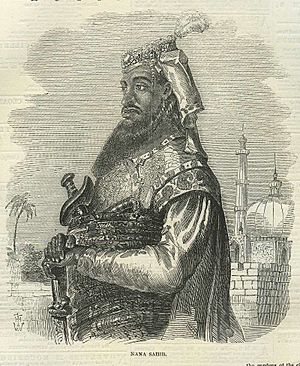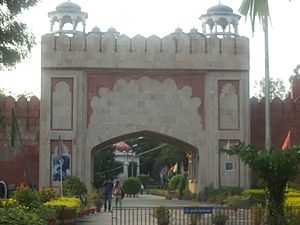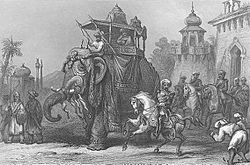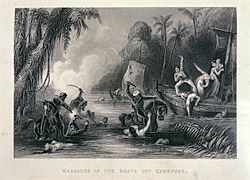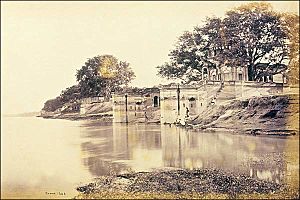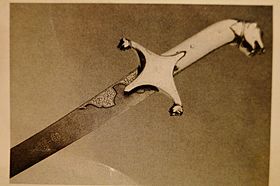Nana Saheb Peshwa II facts for kids
Quick facts for kids
Nana Saheb Peshwa II
|
|
|---|---|
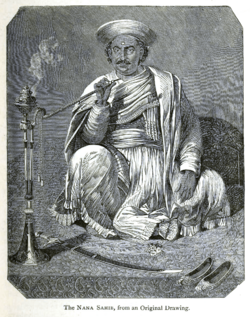 |
|
| 14th Peshwa of the Maratha Empire (Pretender) | |
| Preceded by | Baji Rao II |
| Succeeded by | Position extinct |
| Personal details | |
| Born |
Dhondu Pant
May 19, 1824 Bithur, Cawnpore, Ceded and Conquered Provinces, Company India (present-day Kanpur district of Uttar Pradesh) |
| Died | September 24, 1859 (aged 35) (disputed) Naimisha Forest, Nepal |
| Parents | Narayan Bhat (father) Ganga Bai (mother) |
Nana Saheb Peshwa II (born Dhondu Pant, 19 May 1824 – 24 September 1859) was an important Indian leader. He was a Peshwa (a prime minister or chief minister) of the Maratha empire. Nana Saheb led a major uprising in Kanpur during the Great Revolt of 1857.
He was the adopted son of the last Maratha Peshwa, Baji Rao II. Nana Saheb believed he should receive a pension from the East India Company. However, the Company stopped the pension after his father's death. This, along with other Company policies, led him to join the rebellion. He took control of Kanpur for a short time. After his forces were defeated, he disappeared. Many believe he fled to Nepal and died there.
Contents
Early Life and Family
Nana Saheb was born on 19 May 1824, named Dhondu Pant. His parents were Narayan Bhat and Ganga Bai. After the Maratha forces lost the Third Maratha War, the East India Company sent Peshwa Baji Rao II to live in Bithoor near Kanpur.
Nana's father, a well-educated Brahmin, moved his family to Bithoor. He became a court official for the former Peshwa. Since Baji Rao II had no sons, he adopted Nana Saheb and his younger brother in 1827. Nana Saheb grew up with friends like Tatya Tope, Azimullah Khan, and Rani Lakshmibai. Tatya Tope was his fencing teacher. Azimullah Khan later became an important advisor to Nana Saheb.
Understanding the Doctrine of Lapse
The "Doctrine of Lapse" was a policy created by Lord Dalhousie. He was the British Governor-General of India from 1848 to 1856. This rule stated that if an Indian ruler died without a direct heir, their state would automatically become part of British territory.
This policy ignored the long-standing Indian tradition of adopting a successor. The British also decided if a ruler was "competent" enough to rule. Many Indians saw this policy as unfair and illegal. It was a major reason for unhappiness among Indian rulers and people.
Nana Saheb's Role in the 1857 Uprising
Nana Saheb initially gained the trust of Charles Hillersdon, the British Collector of Kanpur. There was a plan for Nana Saheb to gather 1,500 soldiers to help the British if the rebellion reached Kanpur.
However, on 6 June 1857, when the rebellion started in Kanpur, Nana Saheb changed his mind. He and his forces entered the British magazine (a place for weapons and ammunition). He announced that he was joining the rebellion against the Company. He declared himself a supporter of Bahadur Shah II, the Mughal Emperor.
After taking the Company's treasury, Nana Saheb moved towards Kanpur. He wanted to bring back the Maratha confederacy. He met rebel Company soldiers who were going to Delhi. Nana convinced them to return to Kanpur and help him fight the British. He promised them double pay and gold if they destroyed the British fort.
Attacking the British Fort
On 5 June 1857, Nana Saheb warned General Wheeler of an attack. The next day, his forces attacked the British fort at 10:30 am. The British were not fully ready but managed to defend themselves. The Indian forces were hesitant to enter the fort, believing it had exploding trenches.
The British soldiers held out in their makeshift fort for three weeks. They had very little water and food. Many died from heatstroke and thirst. More rebel soldiers joined Nana Saheb as news of the siege spread. By 10 June, he was leading about 12,000 to 15,000 Indian soldiers.
Nana Saheb's forces surrounded the fort and set up firing positions. The British captain, John Moore, fought back with night attacks. Nana Saheb then moved his headquarters further away. The fighting continued until 23 June 1857. A prophecy had predicted the Company's downfall exactly 100 years after a famous battle. This led Nana Saheb's soldiers to launch a big attack on 23 June, but they could not break into the fort.
Events at Satichaura Ghat
On 27 June, the British, mostly unarmed civilians, including women and children, left their fort. Nana Saheb provided carts and elephants to help them reach the river. British officers were allowed to keep their weapons. They were escorted by many rebel soldiers to the Satichaura Ghat (a riverbank).
At the ghat, Nana Saheb had arranged about 40 boats for their journey to Allahabad. However, the boats were stuck in the mud, making it hard to leave. As the first boat managed to float away, three shots were fired. This was a signal to attack. The Indian boatmen jumped into the water and swam away. Some boats also caught fire.
What exactly happened next at Satichaura Ghat is debated by historians. The departing Europeans were attacked by rebel soldiers. Most were either killed or captured. Some British officers later claimed Nana had planned the attack. However, no clear proof has been found that Nana Saheb ordered the massacre. Some historians believe it was a result of confusion.
During the chaos, Nana's general, Tatya Tope, reportedly ordered soldiers to fire on the Europeans. Rebel cavalry soldiers entered the water to kill the remaining British men. The men who survived were killed. Women and children were taken prisoner, as Nana Saheb did not approve of their killing. About 120 women and children were taken to Savada House, Nana Saheb's headquarters.
The rebel soldiers also chased General Wheeler's boat. The Europeans on board surrendered and were taken back to Savada House. The surviving men were killed. The women and children were taken to Bibighar, a house in Kanpur.
The Bibighar Incident
The surviving women and children, about 120 of them, were moved to Bibighar ("the House of the Ladies"). More women and children from other areas were also brought there, making a total of around 200 captives.
Nana Saheb assigned a woman named Hussaini Khanum to care for the prisoners. He planned to use them to bargain with the East India Company. Meanwhile, British forces under General Henry Havelock were advancing to retake Kanpur. Nana demanded that the British retreat, but they continued to advance.
On 12 July, Havelock's forces defeated Nana's army at Fattehpore. On 15 July, they won another battle. As the British got closer, Nana Saheb and his advisors, including Tatya Tope and Azimullah Khan, discussed what to do with the captives. Some advisors wanted to kill the captives as revenge for British actions. The women of Nana Saheb's family opposed this idea and even went on a hunger strike, but their efforts failed.
British Recapture of Kanpur
British forces reached Kanpur on 16 July 1857. General Havelock attacked Nana's forces and won. Nana Saheb then blew up the Kanpur magazine (weapon storage) and retreated to Bithoor. When British soldiers learned about the Bibighar incident, they reacted with violence, looting and burning houses.
On 19 July, General Havelock's troops occupied Nana Saheb's palace in Bithoor without a fight. They seized weapons, elephants, and camels, and then set the palace on fire. Many British search parties tried to capture Nana Saheb, but he always managed to escape. He once left his sword behind in his hurry to flee.
Nana Saheb's Disappearance
Nana Saheb disappeared after the British recaptured Kanpur. His general, Tatya Tope, tried to retake Kanpur in November 1857 but was defeated.
In September 1857, there were reports that Nana had died of fever, but this is uncertain. In June 1858, Rani Lakshmibai, Tatya Tope, and Rao Saheb declared Nana Saheb as their Peshwa in Gwalior.
The Nepal Connection
By 1859, it was reported that Nana had fled to Nepal. Some accounts say he lived there under the protection of the Prime Minister of Nepal, Jang Bahadur Rana. His family also received protection. In February 1860, the British learned that Nana's wives were in Nepal. Nana himself was believed to be living deeper inside Nepal. Some early records suggest he died in Nepal in 1859 after a tiger attack, but this is disputed. His final fate remains unknown.
A Brahmin named Venkateshwar claimed to have met Nana Saheb in Nepal in 1861. Until 1888, there were rumors and reports of his capture, and several people claimed to be the aged Nana. However, these reports were false. There were also stories of him being seen in Constantinople (modern-day Istanbul).
Other Theories of His Fate
Two letters and a diary found in the 1970s suggest Nana Saheb lived as a holy man, Yogindra Dayanand Maharaj, in Sihor, Gujarat, until his death in 1903. The diary records his arrival in Sihor after the rebellion failed. It also states that he died in 1903. Some of his belongings are still displayed there.
Another account by K. V. Belsare claims that after losing the battle, Nana Saheb went to the Naimisha Forest. There, he met a saint who offered him safety. According to this book, he lived there from 1860 until his death in 1906. The book states that the saint performed his last rites. The truth of these claims is not officially confirmed.
After India gained independence in 1947, Nana Saheb was honored as a freedom fighter. The Nana Rao Park in Kanpur was built in honor of him and his brother, Bala Rao.
| Preceded by Bajirao II |
Peshwa 1851–1857 |
Succeeded by none |
See also
 In Spanish: Nana Sahib para niños
In Spanish: Nana Sahib para niños
- List of people who disappeared
- Ethnic communities in Kanpur
- Nana Fadnavis


